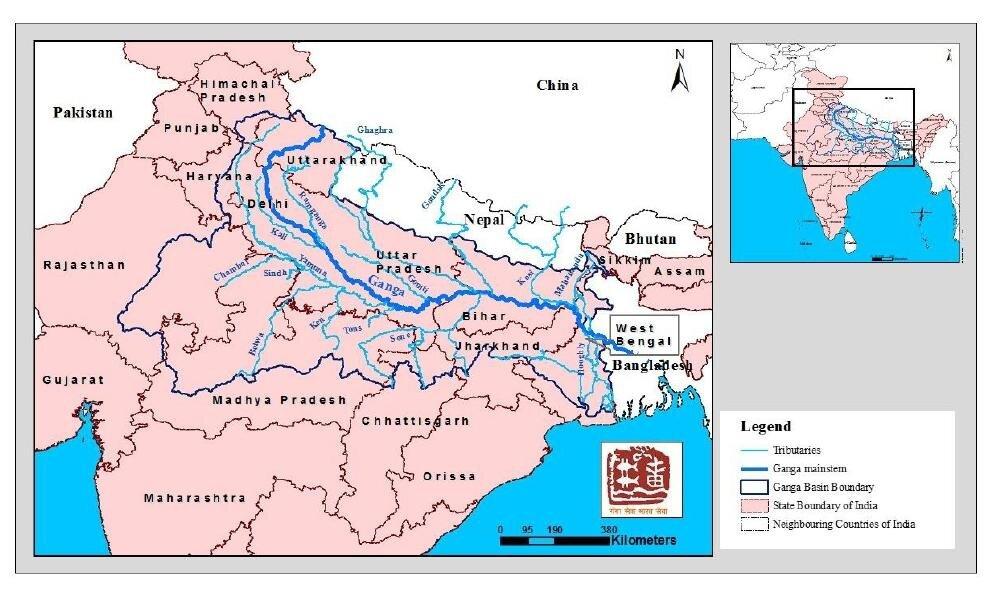Ganga Utsav 2021-The River Festival | 02 Nov 2021
Why in News
Recently, the 5th edition of Ganga Utsav-The River Festival 2021 has begun which celebrates the glory of the National river Ganga.
- Ganga was declared as the National River of India on 4th November 2008.
- The event will also comprise, launch of the Ganga Tarang Portal, curtain raiser on Ganga Knowledge Portal and many more.
Key Points
- About:
- The National Mission for Clean Ganga (NMCG) celebrates the festival every year to strengthen the Public – River Connection.
- NMCG is the implementation wing of National Ganga Council, set up in 2016, which replaced the National Ganga River Basin Authority (NRGBA).
- The NMCG has been registered in the Guinness Book of World Records on the first day of Ganga Utsav 2021 for the highest number of photos of handwritten notes that were uploaded on Facebook in an hour.
- The Utsav celebrates the mystical and cultural river Ganga through storytelling, folklore, dialogues with eminent personalities, quizzes, displaying traditional artforms, dance and music performances by renowned artists, photo galleries and exhibitions and much more.
- It highlights the significance of Jan Bhagidari (People's Participation) in the revival of Ganga, with a focus on encouraging stakeholder engagement and public participation towards the rejuvenation of river Ganga.
- The National Mission for Clean Ganga (NMCG) celebrates the festival every year to strengthen the Public – River Connection.
- Programmes Held During the Festival:
- Continuous Learning and Activity Portal:
- Continuous Learning and Activity Portal (CLAP) is a learning portal that will be buzzing with activities, quizzes, crosswords, discussion forums to keep children engaged throughout the year.
- The objective of all the activities will be to sensitize and motivate the children and youth for action to protect and restore our rivers.
- Ganga Mashal:
- It is an expedition led by the Ganga Task Force (GTF) that will travel the route including 23 stations along the river Ganga which will help sensitization of the local people and bodies like Nehru Yuva Kendra Sangathan) and Voluntary groups such as Ganga Mitras, Ganga Praharis, Ganga Doots.
- Ganga Mitras, Ganga Praharis, Ganga Doots are dedicated voluntary groups formed at the grassroot level, whose resources are channelized for engagement of the community and public at large.
- GTF is a unit of battalion of ex-servicemen deployed in the services of the Ganga with the approval of the Ministry of Defence for the period of four years till December 2020.
- It is an expedition led by the Ganga Task Force (GTF) that will travel the route including 23 stations along the river Ganga which will help sensitization of the local people and bodies like Nehru Yuva Kendra Sangathan) and Voluntary groups such as Ganga Mitras, Ganga Praharis, Ganga Doots.
- Ganga Quest:
- It is a national online quiz on Ganga, rivers, and environment that was first conceptualized in 2019 as an educational program to sensitize children and youth towards River Ganga to strengthen the Namami Gange program.
- Continuous Learning and Activity Portal:
- Government Initiatives on River Ganga:
- Ganga Action Plan: It was the first river action plan to improve the water quality by the interception, diversion and treatment of domestic sewage.
- The National River Conservation Plan is an extension to this plan, which aims at cleaning the Ganga river under Ganga Action Plan phase-2.
- National River Ganga Basin Authority: It was formed in the year 2009 under Section-3 of the Environment Protection Act 1986.
- Clean Ganga Fund: In 2014, it was formed for cleaning up of the Ganga, setting up of waste treatment plants and conservation of biotic diversity of the river.
- Bhuvan-Ganga Web App: It ensures the involvement of the public in the monitoring of pollution entering into the river Ganga.
- Ban on Waste Disposal: In 2017, the National Green Tribunal (NGT) banned the disposal of any waste in the Ganga.
- Ganga Action Plan: It was the first river action plan to improve the water quality by the interception, diversion and treatment of domestic sewage.
River Ganga
- It is the longest river of India flowing over 2,510 km of mountains, valleys and plains and is revered by Hindus as the most sacred river on earth.

- It originates in the snowfields of the Gangotri Glacier in the Himalayas as the Bhagirathi River and is joined by other rivers such as the Alaknanda, Yamuna, Son, Gumti, Kosi and Ghagra.
- The Ganga river basin is one of the most fertile and densely populated areas of the world and covers an area of 1,000,000 sq. km.
- The Ganges River Dolphin is an endangered animal that specifically habitats this river.
- The Ganga widens out into the Ganges Delta in the Sundarbans swamp of Bangladesh, before it ends its journey by emptying into the Bay of Bengal.
